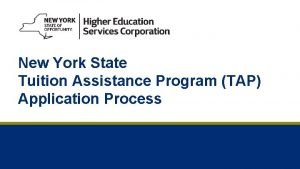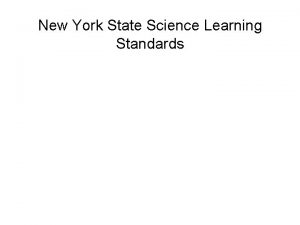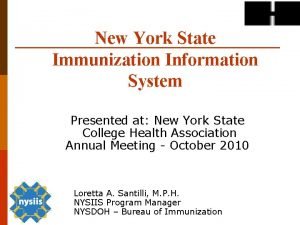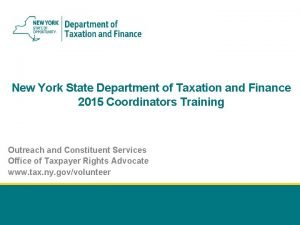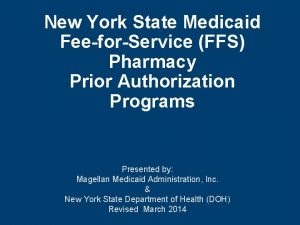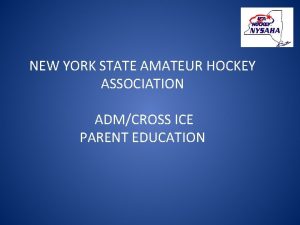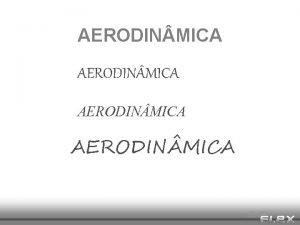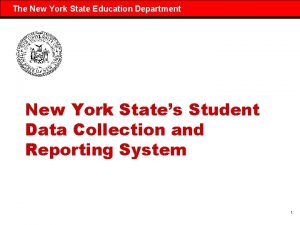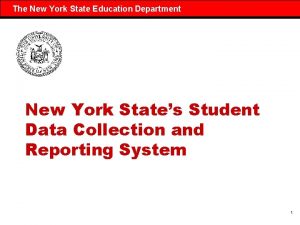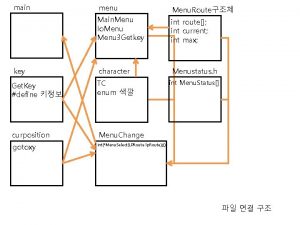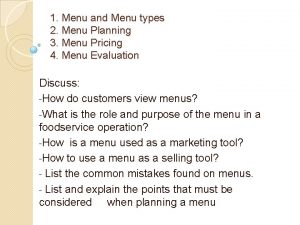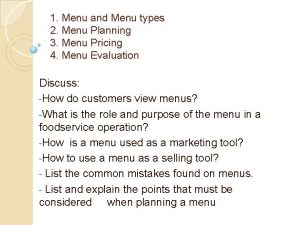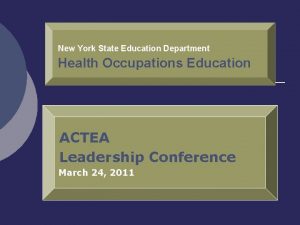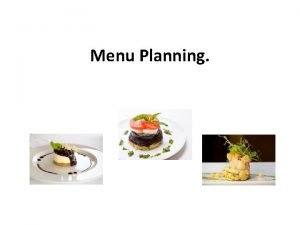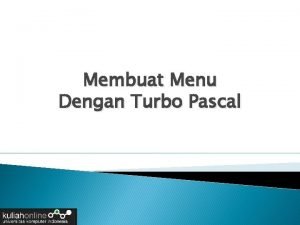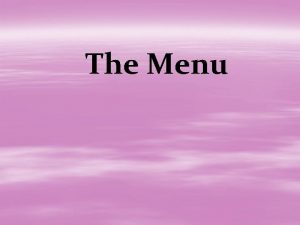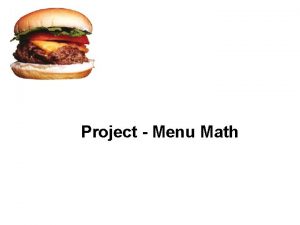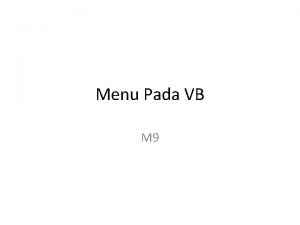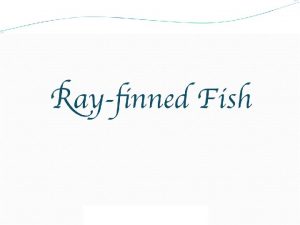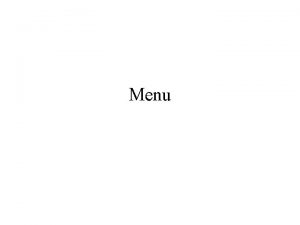Menu Planning Tools New York State Education Department



























- Slides: 27

Menu Planning Tools New York State Education Department Child Nutrition Program

What Resources Are Available For Menu Planning? • NYSED Child Nutrition Knowledge Center • Food Based Menu Planning button http: //portal. nysed. gov/portal/page/pref/CNKC • USDA’s Food Buying Guide- Updated! http: //teamnutrition. usda. gov/Resources/foodbuyingguide. html • National Food Service Management Institute http: //www. nfsmi. org

What Tools Are Required For Planning A Menu? 7 CFR § 210. 10(a)(3) • Nutrition Information • Child Nutrition (CN) Labels • Product Formulations Statements • Nutrition Fact Labels • Standardized Recipes • Production Records • Menu

Child Nutrition Program (CN) Labels A CN labeled product will always contain the following: • The CN logo, which is a distinct border • The meal pattern contribution statement • A unique 6 -digit product identification number (assigned by FNS) appearing in the upper right hand corner of the CN logo • The USDA/FNS authorization statement • The month and year of final FNS approval appearing at the end of the authorization statement • The remaining required label features: product name, inspection legend, ingredient statement, signature/address line, and net weight • http: //www. fns. usda. gov/cnd/cnlabeling/authorized. htm

Sample CN Label Chicken Stir-Fry Bowl Ingredient Statement: Chicken, brown rice, broccoli, red peppers, carrots, onions, water, olive oil, soy sauce, spices. CN CN 099135 Each 4. 5 oz. Chicken Stir-Fry Bowl provides 1. 5 oz. equivalent meat, 1. 0 oz eq grains, ¼ cup dark green vegetable, ¼ cup red/orange vegetable, and ⅛ cup other vegetable for Child Nutrition Meal Pattern Requirements. (Use of this logo and statement authorized by the Food and Nutrition Service, USDA XX/XX). CN Net Wt. : 18 pounds Chicken Wok Company 1234 Kluck Street Poultry, PA 12345 CN

Invalid CN Label

Product Formulation Statement

Nutrition Fact Labels Ranch Dressing Labels are required for all processed foods.

EXHIBIT A: School Lunch and Breakfast Whole Grain Rich Ounce Equivalency (oz eq) Requirements For School Meal Programs

Calculating Grain Ounce Equivalency Using Exhibit A This is a label from a popular cereal bar containing fruit. The label states: Child Nutrition Program: 1 bread equivalent Is this acceptable? NO! If we don’t have a CN label or a PFS, we use Exhibit A to calculate the ounce equivalency based on the weight of the whole product. Which category on Exhibit A would we use? Group E - cereal bar containing fruit How many grams is equal to a one ounce equivalent in Group E? 69 grams How many grams does the cereal bar weigh? 37 grams

Calculating Grain Ounce Equivalency Using Exhibit A Calculation: � 37 grams ÷ 69 grams = 0. 53623 � Always round down to the nearest quarter � 0. 53623 = 0. 50 � This cereal bar is actually 0. 5 ounce equivalent. � You would have to serve two cereal bars to equal the required one ounce equivalent of grain for the school breakfast program.

Breakfast Sausage

Standardized Recipes • Have been tested, modified and retested several times • For consistent quality and quantity • Use exact directions and procedures • Use same type of equipment and quality of ingredients • Train staff on the importance of following the recipe

Required Elements of Standardized Recipes 7 CFR § 210. 10(1)(8) • Recipe Name/Number • Ingredients • Weights and Measures • Servings • Yield • Directions

Advantages of Standardized Recipes • Ensure product quality • Consistency in menu planning • Provide supporting documentation to show meal pattern requirements are met • Costs are easier to control • Same quality results can be produced time after time

Production Records 7 CFR § 210. 10(a)(3) • Daily documentation of what was planned, prepared and served at your foodservice operation • Necessary to support the claim for reimbursable meals • Identifies information needed for the nutrient analysis • Required for Breakfast, Lunch and Snack programs

Required Elements of a Production Record • All Food Items on the Reimbursable Meal -including condiments and toppings • Recipe or Product Name/Number • Portion Sizes/Equivalents for Each Age/Grade Group • Amount/Quantity Prepared • Planned Number of Servings for the Reimbursable Meal • Actual Number of Servings for the Reimbursable Meal • Number of Non Reimbursable Portions Served (adult meals, a la carte and second meals) • Number of Leftover Portions • Date

Production Record Form

Complete Before Service Prefill: • School/Site • Date • Menu Item • Recipe or Product Name/Number • Portion Size • Planned Number of Servings • Student • Adult/2 nd/A La Carte

Complete the Day of Service Fill in when service is over: • Amount Used • Actual Number of Servings • Student • Adult/2 nd/A La Carte • Leftovers • Time & Temperatures (Optional) • Total Reimbursable Meals Served • Substitutions • Comments & Notes

Weight vs. Volume Peaches, canned Weight: 6 oz. = 92 calories Volume: ¾ cup = 102 calories Cheese, grated Weight: 2 oz. = 212 calories Volume: ¼ cup = 84 calories French Fries, potato puffs Weight: 4 oz. = 252 calories Volume: ½ cup = 142 calories

Example of Poorly Completed Production Record

Common Production Record Errors • Missing Information • Incorrect Information Recorded • Portion Sizes Not Quantified • Weights vs. Volume • Missing Condiments • Missing Daily Items • Not Legible

Menu and Production Record Daily Menu Daily Production Record

Nutrient Analysis Done by LEA • USDA approved software • Appropriate age/grade groupings • All food items included in analysis • Data entered correctly • Data reasonable • Weighted average • Planned servings • Meet key nutrients

Consistent & Current • All supporting documentation for your menu should be consistent and current! • • Nutrition Information Standardized Recipes Production Records Nutrient Analysis For Example • Monday you serve: • • • Spaghetti and Meatballs Dinner Roll Green Beans Pears Fat Free Chocolate Milk 1% White Milk

Child Nutrition Program Contact Information • Thank You! • For questions, please contact your Child Nutrition Representative at: • Please frequently refer to the Child Nutrition Knowledge Center website:
 How many roundabouts in new york
How many roundabouts in new york Nyc department of youth
Nyc department of youth Nurse practitioner association of new york state
Nurse practitioner association of new york state New york state tap application
New york state tap application New york state teacher certification exams
New york state teacher certification exams New york state science standards
New york state science standards 2018 nys math test
2018 nys math test New york mesonet
New york mesonet New york state vegetable
New york state vegetable Environmental facilities corporation
Environmental facilities corporation New york state professional firefighters association
New york state professional firefighters association What is nysiis
What is nysiis New york state association of transportation engineers
New york state association of transportation engineers Nys industries for the disabled
Nys industries for the disabled Nys division of criminal justice services
Nys division of criminal justice services New york state reliability council
New york state reliability council 414hsub
414hsub New york state nurse practitioner scope of practice
New york state nurse practitioner scope of practice New york state fish
New york state fish New york state nickname
New york state nickname New york state medicaid prior authorization
New york state medicaid prior authorization New york state amateur hockey association
New york state amateur hockey association New york state county highway superintendents association
New york state county highway superintendents association New york, new jersey, pennsylvania, and delaware
New york, new jersey, pennsylvania, and delaware Marquee cinemas orchard 14
Marquee cinemas orchard 14 Articles of confederation strengths and weaknesses
Articles of confederation strengths and weaknesses Both new hampshire and new york desire more territory
Both new hampshire and new york desire more territory Oklahoma state department of education standards
Oklahoma state department of education standards



